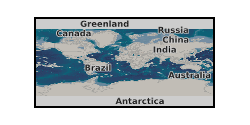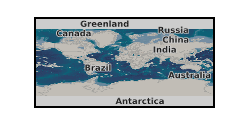Hydrostatic pressure
Type of resources
Topics
Keywords
Contact for the resource
Provided by
Years
Formats
Update frequencies
-

Cyclic loading stress-strain data in polycrystalline antigorite serpentinite, at various confining pressures and temperatures. This dataset is used and fully described/interpreted in the paper: David, E.C., N. Brantut, and G. Hirth, Sliding crack model for non-linearity and hysteresis in the triaxial stress-strain curve of rock, and application to antigorite deformation, submitted to J. Geophys. Res. Overview Rock type Vermont antigorite-rich (>95%) serpentinite. See submitted paper for details. The sample is isotropic. Apparatus Oil-medium triaxial apparatus (Rock Physics Ensemble, University College London). For description, see David el al. (2018), Absence of stress-induced anisotropy during brittle deformation in antigorite serpentinite, J. Geophys. Res., 123, 10616-10644. Griggs-type solid medium apparatus (Brown University). For description, see David, E.C., N. Brantut, and G. Hirth, Sliding crack model for non-linearity and hysteresis in the triaxial stress-strain curve of rock, and application to antigorite deformation, submitted to J. Geophys. Res., and references therein. Files description 1-existing data from David et al., JGR, 2018: The text file "Vermont-antigorite-roomT-150MPa-stress-strain-cyclicloading-UCLtriax" gives the axial stress (in direction 1, see submitted paper) and the axial strain (in percent, in direction 1, see submitted paper), at room temperature and 150 MPa confining pressure, in the oil triaxial apparatus at UCL. The mechanical data (stress, strain) have been corrected from internal friction and machine stiffness, respectively. The data are from David el al. (2018), Absence of stress-induced anisotropy during brittle deformation in antigorite serpentinite, J. Geophys. Res., 123, 10616-10644. 2-new data: The text file "Vermont-antigorite-roomT-1000MPa-stress-strain-cyclicloading-Griggsapparatus" gives the axial stress (in direction 1, see submitted paper) and the axial strain (in percent, in direction 1, see submitted paper), at room temperature and 1000 MPa confining pressure, in Griggs solid medium apparatus at Brown University. The mechanical data (stress, strain) have been corrected from internal friction and machine stiffness, respectively. The text file "Vermont-antigorite-400C-1000MPa-stress-strain-cyclicloading-Griggsapparatus" is the equivalent of the file described just above at a temperature of 400C. The text file "Vermont-antigorite-500C-1000MPa-stress-strain-cyclicloading-Griggsapparatus" is the equivalent of the file described just above at a temperature of 500C.
-

A number of processes, both natural and anthropogenic, involve the fracture of rocks subjected to tensile stress, including vein growth and mineralization, and the extraction of hydrocarbons through hydraulic fracturing. In each case, the fundamental material property of mode-I fracture toughness must be overcome in order for a tensile fracture to nucleate and propagate. Whilst measuring this parameter is straightforward at ambient pressure, estimating the fracture toughness of rocks at depth, where they experience a confining pressure, is technically challenging. Here, we report a new analysis combining results from standard thick-walled cylinder burst tests with quantitative acoustic emission to estimate the mode-I fracture toughness (KIc) of Nash Point Shale at elevated confining pressure, simulating in-situ conditions to approximately 1km. In the most favorable orientation, the pressure required to fracture the rock shell (injection pressure, Pinj) increases from 6.1 MPa at 2.2 MPa confining pressure (PC), to 34 MPa at 20 MPa confining pressure. When fractures cross the shale bedding, the required injection pressures are 30.3 MPa (at Pc = 4.5 MPa) and 58 MPa (at Pc = 20 MPa), respectively. Applying the model of Abou-Sayed (1978) to estimate initial flaw size, we calculate that this pressure increase equates to an increase in KIc from 0.6 MPa.m1/2 at 3.2 MPa differential pressure (Pinj - PC) to 4.1 MPa.m1/2 at 22 MPa differential pressure. We conclude that the increasing pressure due to depth in the Earth will have a significant influence on fracture toughness, which is also a function of the inherent anisotropy.
 BGS Data Catalogue
BGS Data Catalogue